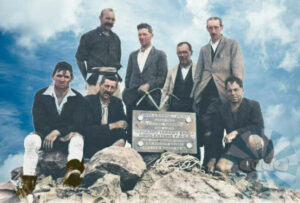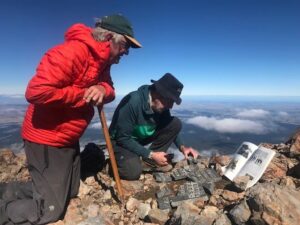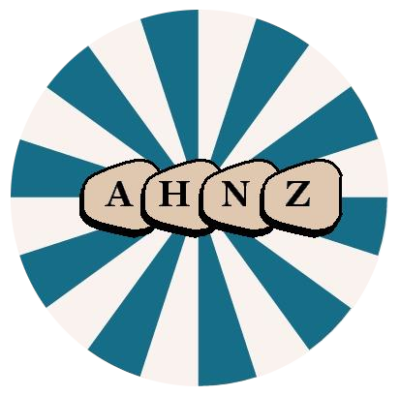1922: Girdleston Peak War Memorial
May 27, 2025
By AHNZ

World War 1 memorial destroyed by a Maori activist and a Feminist writer.
New Zealanders owe a great debt to the contributions of its early surveyors as well as the ANZAC soldiers. Sergeant Hubert Girdlestone (1879-1918) was both of these in one. Hugh, a Fellow of the Royal Geographical Society, had the misfortune to be killed in action fighting World War 1. At home he was surveyor who mapped and measured our country. The results were made official by the government of the day. The work done by Hugh and his comrades determines where the roads, towns, bridges, tracks, etc. we take for granted today are put and that they exist at all. These are the same tracks and infrastructure that the desecrators of Huge’s monument rely upon to smash it to pieces in 2021.
After Hughe was killed in action a peak of Mt Ruapehu, Little Matterhorn, was re-named to honor the untimely end of the man and his future work. It took 3 attempts on the now Girdlestone Peak summit to install a plaque. A team of 8 finally lugged 16kg of marble, concrete, iron and a drill up to the top by expending great effort. As a result it was dated March 1921 in anticipation but not installed until Sunday 12 March, 1922.
It was well-earned as well as official. Girdlestone and and his old mates, early surveyors, had climbed the peaks many times to map and measure New Zealand for all of us.
Any time I find a sign in the wilderness like this of people who came before me I feel a privileged connection to the past. I know that I’m one of a minority of people to have come this way but that I’m not alone but have ancestors of this journey who left something for me. It’s a mix of earned pride and exclusivity, a restricted secret I get to be a part of now.
That is evidently not the sentiment of the Maori activist and the Feminist who smashed and removed the war memorial from Girdlestone Peak in 2021. The activist evidently felt race-based hate. The Feminist? Years and many pages of published reflections later and Hazel Phillips still hasn’t “identified that reason.”
“”What pseudonym do you want in my book?” I yelled out. — We were climbing up a short section of the Skyline Ridge on Ruapehu.” – first line of Phillips article: Destroying a Pākehā memorial on Ruapehu. Newsroom (May 2025)
“Hugh Girdlestone, bastion of climbing, mountain enthusiast and surveyor of Tongariro National Park, a man who spent his days ascending peaks and his nights camped beneath stars on the rocky volcanic slopes of the maunga, a man stout of stature and blessed at times with a bushy handlebar moustache, did not die on the mountains of the central plateau he loved so much; he did not come to grief crossing a swift river of glacier melt, nor did he perish from speeding ballistics ejected violently from Ruapehu’s crater; no — Hugh Girdlestone died from shrapnel flying across a battlefield, piercing his tent and then his flesh. Girdie, they called him affectionately.” – Hazel Phillips, The Spinoff (2025)
“…it was history, after all — but I’d been an accessory to removing it from the backcountry. There had been a reason, even if I hadn’t yet identified that reason precisely to myself.” – ibid
Owen Campbell “…returned to Ruapehu as part of a group who packed marble, concrete, iron and drills to the top of Girdlestone
Peak /Peretini, to erect a memorial to Girdlestone who died in the Great War. The peak, which was named for Hugh after the war, is known by local iwi as Peretini. It was also for a time called Little Matterhorn. However, storms prevented the installation, so the team returned in 1922 to finish the job..” – Bamford (2020)“Government surveyor, based in Wellington. Alpine climber, Fellow of the Royal Geographical Society. Sergeant in the first World War, killed in action August 28, 1918. In 1922 Matterhorn Peak in Tongariro National Park was renamed Girdlestone Peak in his honour.” – National Library
“Girdlestone Peak. To the memory of Hubert Earle Girdlestone, F.R.G.S., killed in France, 28th August, 1918. Erected 23rd March, 1921.” – inscription on the plaque
1 April 1922, “Placing of a plaque on Girdleston Peak, Mt Ruapehu, to commemorate H.E.Girdlestone, climber” – Two Hundred Years of New Zealand History, A.W.Reed (1979) [contradicts newspapers. eg Evening Post, NZ Times]
“Was there when that was taken. – From the book article – If ‘Henry’ wanted rid of the Girdlestone Plaque, why did ‘He’ not remove it completely. There was in fact a Fund of Forty Pounds, set up for its maintenance, I inspected it for the Park Board in 1961 and it was in perfect condition.” – Comment to Newsroom, Facebook (2025)
 Phillips didn’t go to the police when she witnessed a Maori activist smashing an alpine memorial with a rock and hammer. She normalised him, protected his identity, suggested a fake name, publicised the act in her new book for Massey University Press. In most circumstances someone in this position would be trying to avoid incriminating themselves further and defending criminal charges. Thanks to an historically unprecedented amount of Privilege this woman gets to profit from it instead with a book deal!
Phillips didn’t go to the police when she witnessed a Maori activist smashing an alpine memorial with a rock and hammer. She normalised him, protected his identity, suggested a fake name, publicised the act in her new book for Massey University Press. In most circumstances someone in this position would be trying to avoid incriminating themselves further and defending criminal charges. Thanks to an historically unprecedented amount of Privilege this woman gets to profit from it instead with a book deal!
The sequence played out like this.
In 2020/1 a Maori Activist (whose identity Hazel is protecting) set out on a premeditated climb to smash the 1921 surveyor’s memorial. Grabbing a big rock, he pounded it repeatedly into the face of the plaque like an angry caveman. The shattered marble he threw to the four winds.
Next, in April 2021, author and outdoorsman Dave Bamford arrived on the scene of the vandalism. He was making a pilgrimage journey in memory of his grandfather from 1921 who had put the tablet on the mountain. Bamford’s party spent an hour of their 10 hour climbing day gathering up the pieces and re-assembling them. He mistakenly supposed that nature had smashed his heritage and not an angry man. “It was initially a shock to discover the granite plaque to Girdlestone had been shattered fairly recently by the ravages of time and nature —frost and thaw.” – Dave Bamford, Facebook (2021)
Next came the Activist and the Feminist to undo the restoration effort and inflict even more damage! This time, he brought a hammer.
“…with the specific intention of destroying the memorial. Grabbing a big rock, he pounded it repeatedly into the face of the plaque.”
“You write in there that the fulla who did this is as white as they come,” he said. “Who the fuck are you to come up here and put this up here?”
“..he picked up the shattered pieces and cast them off the peak.”
“Fucking white people and their sense of entitlement,”
“….used a hammer to bash at the valves sideways, pushing them around to weaken them on the neck.”
“I’d be so embarrassed if someone put a plaque up for me because I fell off a mountain or something”
“..he has some Māori heritage somewhere in his family, but he’s never really been engaged” – Destroying a Pākehā memorial on Ruapehu, Newsroom (26/5/2025)
Instead of stopping the activist, Hazel joined him. Kept look-out, provided moral support, an alias, became his climbing buddy, and publicist. Helped him remove the shattered monument so nobody could put humpty back together again.
The Activist was evidently driven by race hate as evidenced by his abusive foul language. Superficially it’s the same motive as Mike Smith in killing the One Tree of One Tree Hill. Or, Francis Shaw’s arson of Rangiatea Church. Or, Tuhoe tribesmen burning down the Urewera huts. The list goes on. The line about it being an “embarrassment” shows two things. Firstly, Activist was totally ignorant of the meaning and history of what he had destroyed so he was projecting personal problems onto an innocent object. He thought Hugh was some climbing accident fatality which suggests he was illiterate or the inscription would have told him otherwise. Secondly, he had a prick of conscience for the act because he needed to treat it with an excuse as if he were doing Girdlestone a favour. Reading into it, he was perhaps also emoting a bit of lonely isolation to Hazel that he isn’t the sort of person who could accept being loved or missed were he to be killed.
As for our stunning and brave trailblazer cheering on the activist vandal while he destroys monuments he doesn’t even understand…what was her motive? High in Agreeableness, she appears to have switched into full on Patty Hearst Stockholm Syndrome right away and joined right in. Her Feminism is probably a Reaction Formation toward her unhealed inclination to do as men tell her. Meeting a violent activist in a smashing rage in a remote exposed place is dangerous to a solo woman so Fight/Flight/Freeze could get her killed. There’s another F: Fawn. The Feminist ideology or decolonisation Marxist stuff she might come up with later would only be fluff on top of this, I think. Like that other angry Feminist who hated on our heritage, Sasha Huber, there’s some unresolved wounds of childhood at the basis of this Acting Out.
As they walk the trails surveyed and mapped by the men whose memory they smash nobody arrests them. The Police have recently let slip that their “value thresholds” are – general theft $200, petrol drive off $150, shoplifting $500, fraud $1000, and all other fraud $500. The government’s enforcers must look very dimly on the value of a 100 year old bit of marble nobody owns. And there’s only a privileged white woman with friends in high places to arrest; Not good optics. Not in the “public interest.” Ref. Confusion over how police investigate crimes after secret memo, ODT (May 2025)
Nor will the Mainstream Media stand up for heritage and history. Massey University Press, Spinoff, Radio NZ, and Newsroom are all platforming and promoting the desecrators of an ANZAC war memorial. Thousands of of copies of Hazel’s book Fire and Ice are already being sold in Whitcoulls etc. and on the shelves of our public libraries. Next thing you know they’ll finish the hit job by changing Girdleston Peak into a Maori name.
Oddly, but as per usual, the only place to read anyone who will back up the ANZAC soldier, the government surveyor, the New Zealand that everyone considered normal status quo until about 2016, is Anarchist History of New Zealand.
—
Image ref. Girdlestone Plaque Team on 1 April, 2022. The Boys from Waipu, Dave Bamford (2020,) Auckland Museum. AHNZ colour (2025)
Image ref. Modified cover of Phillips book. AHNZ (2025)
Image ref. Bamford tries to repair his grandfather’s legacy. Facebook (2021)
Ref. Survey party including H E Girdlestone, at Mokai Patea block. Alexander Turnbull Library
Ref. The Boys from Waipu, Dave Bamford (2020,) Auckland Museum
 Like Comment Share
Like Comment Share





